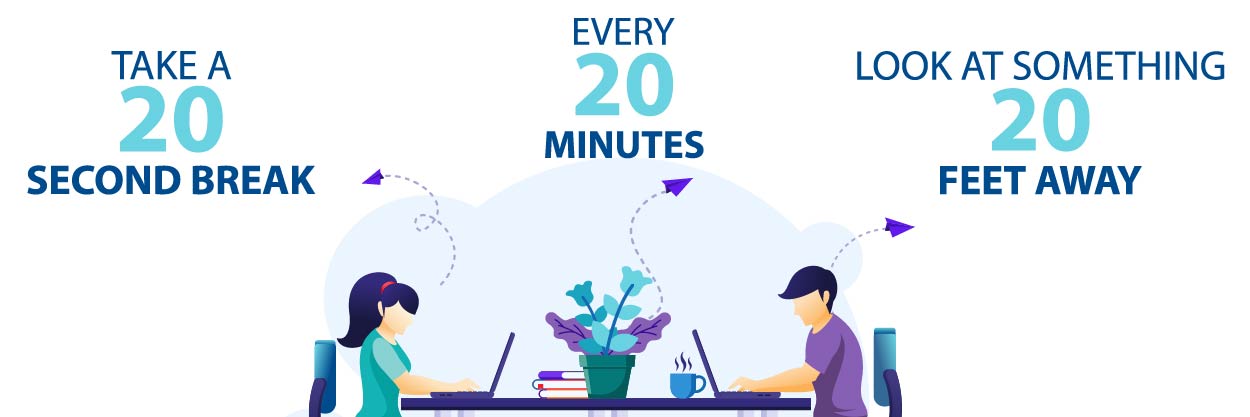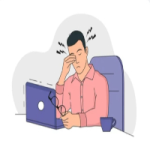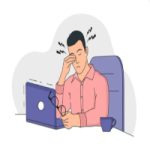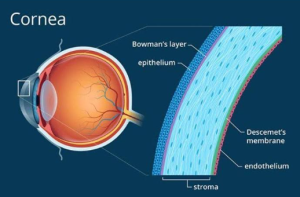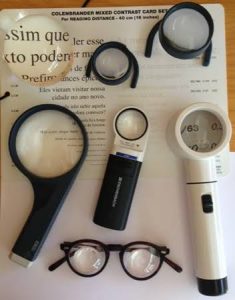The significant increase in the use of digital screens in our daily life requires advanced research
to avoid possible ocular damage (1). The use of a digital screen affects the blinking pattern and
blinking rate, which in turn alters the homeostasis of the ocular surface (2).
Researchers have advised several therapeutic and management options to make this happen,
one approach includes the 20/20 rule. The 20-20-20 Rule means to fixate on an object 20 feet
(6m) away after every 20 minutes near work for 20 seconds to relieve eye strain, especially in
computer users (1).
Computer Vision Syndrome (CVS):
Computer Vision Syndrome (CVS) is becoming more known because of the increasing range of
computer users experiencing ocular discomfort. The prevalence of CVS goes up to 90% among
screen users. Symptoms include asthenopia, ocular surface, and visual-related complaints (3).
Along with the frequent use of computers, it is also suggested that proper posture and sitting of
the user matters in developing CVS. It is also responsible for reducing the productivity of the
employers and more compromised vision (4).
Since the COVID-19 pandemic, the demand for remote work is increasing, globally (5). Thus,
CVS is an important visual problem of society that needs to be addressed (4).
20/20 Rule in Clinical Practice:
Many professional eye care practitioners recommend this rule to their patients in clinical setups
(1). Working at a near distance activates accommodation, and induces miosis and convergence
(3). Studies show 20-20-20 Rule helps in relaxing active accommodation due to continuous long
work hours on computers (6). Reducing near work or having continuous breaks from the screen
can help in reducing CVS symptoms (3). However, the 20-20-20 rule wasn’t reported to
influence any binocular parameters and Dry Eye Disease Syndrome, apart from the fact that the
break from the screen enables computer users to blink more as focus from the screen diverts
(6).
Are ”20 Seconds Every 20 Minutes” Enough?
Some researchers say that 20 seconds break after every 20 minutes is ineffective and they
suspected the break should be longer than 20 seconds, up to approximately 1 minute. There is
no optimal quantity that can be determined. At the same time, the significance of frequent
breaks from near work to relax your eyes can be not ignored. It helps reduce eye strain and
possibly myopia development. Thus, the 20-20-20 rule acts as a reminder to have necessary
breaks for one own benefit (7).
20-20-20 Rule and Myopia Progression:
Myopia or near-sightedness is a refractive error of the eye. It can be corrected through glasses
and contact lenses. One of the primary causes includes elongation of the axial length of the eye,
leading to retinal detachment in severely high degrees of myopia (>=6D). Prolonged near work
is a risk factor for myopia progression (8).
A generalized theory suggests that extensive near work can lead to accommodative and
vergence strain which can result in structural myopia (9). The use of the digital screen on
smartphones, tablets, or computers is a study supported to be associated with myopia.
Increased near-work per week raises 2% of chances of myopia. Thus, sustained near-work is
myopigenic (10). Studies have shown that the 20-20-20 rule can cancel the extended near work
myopia problems by relieving the ocular strain but it is also suggested that more frequent
breaks will not drastically impact the outcome further. This study only supports the results on
animal model data (11).
Association with Refractive Errors:
The 20-20-20 rule cannot fulfill the shoes for refractive glasses. For example, A person with >2-
3D myopia or >1D astigmatism cannot expect to relieve his symptoms only by making the 20-
20-20 rule a habit. Breaks can reduce ocular strain caused by continuous near-work but they
can correct the refractive error of the eye. But, the 20-20-20 rule can be advised with glasses
correction to the patients (9).
Making 20-20-20 Rule a Habit:
Certain ways were introduced over time to monitor computer viewing activities and remind to
take frequent gaps between work. One is an eye-ware system called “Tiger”. It provides real-
time feedback to enable users to develop the 20-20-20 rule as a habit. For better results, a
fusion of multi-sensory modalities was advised (12).
Another application is “Bespoke” computer software using the webcam, which was used by the
researchers to assess user breaks and emit incorporate personalized reminders (6).
These applications can be helpful until you’re developing a habit of the 20-20-20 rule in your
daily routine because developing a habit can be time-consuming, as cognitive and attentional
mechanisms can also play a role (13).

